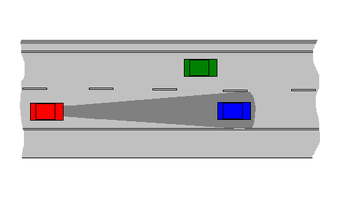Please excuse my ignorance.
When I came across the acronym, ADAS, Advanced Driver Assistance Systems, what popped into my mind was some sort of software or hardware driver – for helping a piece of equipment work inside an application.
However, the indicated ADAS driver in fact sits behind the wheel of a vehicle, typically, a car.
The scope of ADAS is infinite: From an audio beep that prevents you from knocking down your neighbor’s fence while reversing – to automated driverless systems.
The engineering possibilities are limitless as well: cameras, controls, software & hardware drivers, sensors, meters, and more. The designs are not confined to safe driving – entertainment systems and improvements in driver “usability” are driving development in parallel with vehicle safety features.
The idea behind automatic driving is not new. Assisted driving mechanisms in today’s vehicles are no longer considered “extras”.

Schematic of in-vehicle system Intelligent Cruise Control. Red car automatically’ follows blue car (Photo credit: Wikipedia)
Without differentiating between well-known consumer “beeps & whistles” that constitute vehicle extras, and advanced vehicle automation safety design, let’s take a look at some of the driver applications in which semiconductors are embedded.
Semiconductors for Driving
| Devices | Applications |
|---|---|
| Sensors, Comparitors |
|
| Audio Processors |
|
| Motors |
|
| Visual Processors |
|
| Microcontrollers |
|
| Power Regulators |
|
| LEDs & LCDs |
|
But don’t relax too much next time you’re out driving – when you fall asleep at the wheel, you can’t get away with blaming that zener diode again!
